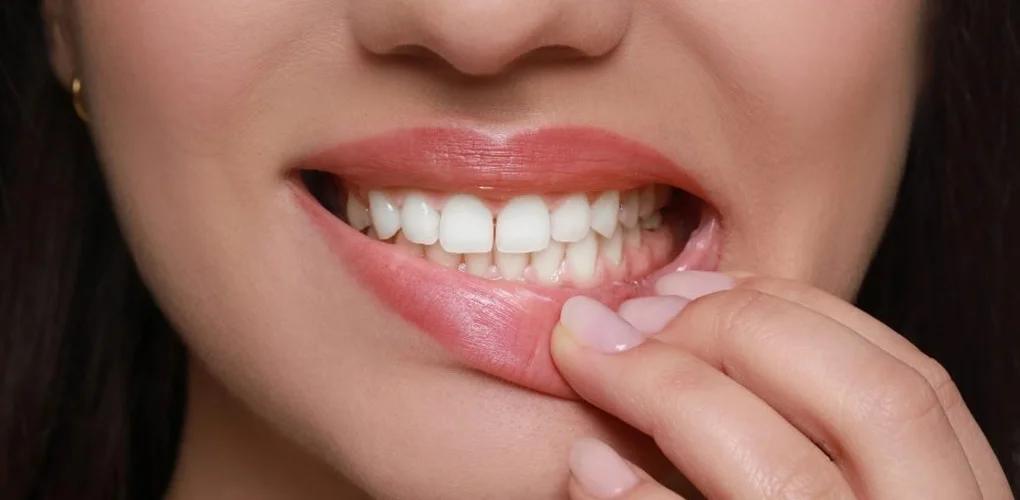`
Gum Recession: Causes, Symptoms, and Treatment Options
Gum recession is the process of gingival tissues pulling away from the margin of the gums. It is a common dental problem that exposes the tooth structure more than normal. Pockets or gaps form between the teeth and gums, allowing the accumulation of disease-causing bacteria. Gum recession can be localized (involving one or two teeth) or generalized (involving multiple teeth).
Gum recession increases the risk of caries, sensitivity, and tooth loss. A receding gum line is not noticeable in the beginning as it occurs gradually. Untreated gum recession results in damage to supporting tissues and alveolar bone. Gum recession cannot be reversed. For this reason, early diagnosis can help to prevent further damage.
Introduction to Gum Recession
Gum recession is a form of periodontal disease characterized by the thinning of gum tissues or the pulling away of gum tissues below the gum line. It makes teeth look longer by exposing root surfaces. Gum recession is a serious consequence of poor oral health. Gum tissues cannot regenerate naturally, but thorough dental cleaning and improved hygiene practices can help maintain healthy gums.
Causes of Gum Recession
Gum recession can occur due to several reasons ranging from oral hygiene practices to bad habits or medical conditions. Some causes of gum recession are as follows:
- Poor oral hygiene
- Aggressive brushing habits
- Trauma to gum tissues
- Malalignment
- Smoking
- Genetics
- Hormonal changes
- Periodontal diseases
- Lip or tongue piercings
Gum recession, regardless of the main cause, can be managed with timely diagnosis. Early treatment of receding gums can help prevent other oral problems.
Symptoms
Gum recession most commonly begins with sensitivity and noticeably longer teeth. It occurs because of plaque and tartar buildup below the gum line. Symptoms of gum recession include:
- Bleeding gums
- Sensitive teeth
- Exposed tooth roots
- Tooth mobility
- Pain or discomfort
- Bone resorption
- Tooth loss
Treatment
Treatment for gum recession depends on the severity of the disease. Mild gum recession can be treated by professional scaling and topical gels, while severe forms require gum correction surgeries.
Scaling and Root Planing
The dentist first removes the plaque and tartar buildup to know the exact position of the gums. Scaling is the removal of tartar buildup from tooth surfaces. Root planing is the removal of plaque from root surfaces. It helps prevent further gum damage.
Medications
The dentist prescribes antibiotics, topical antibiotic gels, and antimicrobial mouthwash to treat the infection and the underlying cause of gum recession.
Surgery
In cases of severe gum recession, surgery is recommended by the dentist or periodontist. Gum grafting surgery is usually performed to fix gum recession. A graft (piece of gum tissue) is taken from the roof of the mouth and placed over the teeth to replace missing gum tissues. This graft helps gum tissues grow back to their original position.
Post-Operative Care
Gum grafting surgery will not be successful if oral hygiene is not maintained. It is important to follow the dentist's instructions. A soft diet with chewing from the opposite side is advised. Avoid sticky, hard, crunchy food and biting foods if surgery is performed on front teeth. Do not skip follow-up appointments as they help the dentist monitor gum growth after surgery.
Prevention
Gum recession is irreversible damage, but it can be prevented by:
- Proper brushing techniques
- Regular dental check-ups
- Mouthwash usage
- Eating a healthy diet
Complications of Gum Recession
If gum recession is left untreated, the following complications might occur:
Root Caries
Gum recession exposes the root surfaces of teeth, allowing food and bacterial accumulation. This bacteria increases the risk of root caries because root surfaces can be more easily damaged than enamel or dentine.
Tooth Loss
Untreated gum recession may lead to bone resorption resulting in tooth mobility and ultimately tooth loss.
Bad Breath
Gum recession forms pockets between the teeth and gums, providing space for plaque buildup and bacteria to accumulate. These bacteria produce sulfur, leading to bad breath or malodor.
`

